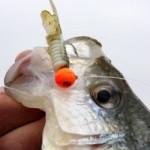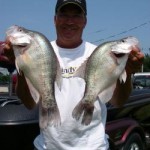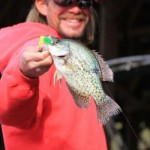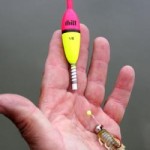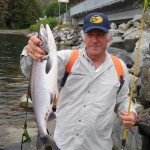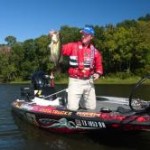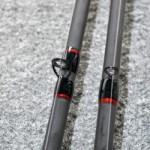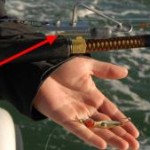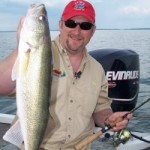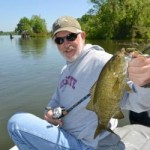Best Areas For Bank Crappie Fishing
by Ray Rudolph
from The Fishing Wire
You don’t need a boat to catch early fall crappies, just a good plan of action. It can be as relaxing or adventurous as you want it to be. Here are the three best areas to focus on to catch a stringer of crappies from the bank.
Way Up The Creek
The odd-looking “Watsit” soft plastic on a jighead makes an ideal late summer and early fall offering for crappies.“I grew up walking creeks,” says crappie guide Barry Morrow. “I’m talking about the uppermost areas of creeks. Most have access within a short walking distance. Access will often be from a backroad or where a bridge crosses the creek. Some have parks or picnic areas that provide easy access. Public lands are best because you must have permission if you walk private land.”
He moves along in search of laydowns, old stumps or other cover where fish might hide. His weapon of choice is an 11-foot pole, 12-pound test Silver Thread line and a 1/4-ounce jighead with a Lindy Fat Watsit body. He agrees that most fishermen are more comfortable with a lighter-weight jighead, but that extra weight allows better sensitivity to feel the bottom, brush and bites.
“Start at the outside edges of brush or laydowns and work toward the inside,” says Morrow. “The best bite is usually in the heart of the cover, but you can pick off aggressive fish from the edges without disturbing those deep in the thick stuff. Every piece of cover has a sweet spot and you’ll soon learn a pattern where most of these are located.”
Guide Barry Morrow says whopper crappies like these can be dredged from brush in creeks with a long crappie pole.His technique requires both hands. Hold the pole in one hand and the line in the other. Pull the jig up to the tip, push the bait where you want it and then drop the jig by slowly moving your free hand toward the pole. Keep dropping it until you feel bottom or reach the strike zone. Controlling the line with your free hand is very important to this style of fishing. Because the rod is often confined within the branches of a laydown tree or bush, use that free hand to set the hook, pull the crappie almost to the tip then back it out.
Spillways for Crappie and More
Spillways damming man-made reservoirs are crappie guide Todd Huckabee’s favorite spots for summertime shore fishing.
“Late summer is the perfect time,” he said. “The lake becomes a little stagnate in late summer with the thermocline, low oxygen levels and water temperature all being stressful on the fish. But in the spillway the water will be cooler and dissolved oxygen levels are great. The fish feel better and are more active.”
He says with fairly uniform oxygen levels throughout the water column of a spillway, crappie can be at any depth. Every spillway is different so there are no ‘cookie cutter’ spots that work everywhere. However, he says two important features, current and eddies, are present at all spillways.
Guide Todd Hucakbee likes a Yum F2 Wooly Beavertail jig in dam spillways in summer.“Many fishermen use a cast and retrieve tactic, but their baits don’t stay in the strike zone long enough. I use a float like the Wobble Bobber to stay above the rocks and to find the eddies. Once a float gets in an eddy it will circle around, which is perfect because the eddy is where baitfish and predator fish are holding. The bite usually happens quickly.”
Equipment includes his signature series 10-foot spinning rod, a float and a YUM F2 Wooly Beavertail jig. He prefers using one jig but says a tandem jig rig is fine if you prefer.
“My best tip: Don’t overlook shallow water,” he said. “Since oxygen levels are the same everywhere, spillway crappie may be very shallow where it is easier for them to ambush food.
“Another great thing about a spillway is you might catch a pound crappie, and on the next cast a white bass, then a 3-pound walleye, a northern or one of the many other species there. Spillway fishing is a lot of fun.”
Surprising Docks
Boat docks are well known crappie magnets, but most boating crappie anglers hit the fronts and maybe halfway down the sides. During summer, especially early and late in the day, the bank-side of docks can be more productive.
“Fish can be at many different locations on a dock but the backside can have the right depths and cover for this time of year,” said Morrow. “Fishing from the bank will put you in the action.”
Morrow casts and pitches using 7- or 10-foot poles spooled with 6- or 8-pound test Silver Thread line. The shorter pole is good for casting and flipping while the 10-foot Huckabee spinning rod is good for vertical dipping, pitching and casting.
Rigs can vary based upon your favorite baits. Morrow says his choice easy.
“I use a Lindy Crappie Cork because I can fish any depth by adjusting it up or down and I can cast it for distance and accuracy. Under the float I like a 1/16-ounce Fuzzy Grub or 1/8-ounce Watsit jig in a natural color. Green pumpkin has always worked well for me in late summer. If the water is super-clear or the fish run on the small side, use a smaller jig.
“I target brushpiles and cover near the backsides of the docks. Sometimes you can see them but most of the time you’ll have to find them by retrieving your bait between the dock and bank. Keep raising the slip float to put the bait deeper until you find cover.”
